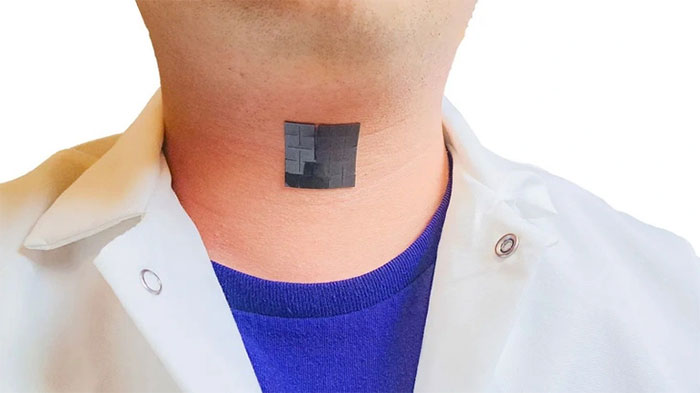The neck-mounted device helps speakers avoid the need for vocal cords
A new device that sticks to the neck could help people who cannot speak due to vocal cord problems communicate.
This small patch-like device can not only detect throat movements, but also harness movement to generate electricity, allowing the device to operate on its own without the need for batteries or charging.

New device helps convert neck muscle movements into speech - (Photo: UCLA).
The study, published March 12 in the journal Nature Communications , could theoretically help people with voice disorders caused by damaged vocal cords or vocal cord paralysis , including those in recovery. after nasopharyngeal cancer surgery.
LiveScience website quoted research team leader Jun Chen, working at the University of California (USA), as saying that the idea for the device appeared after he had a sore throat from lecturing for hours.
According to Mr. Chen, the design of this patch is based on a study (of which he is the lead author) published in 2021 in the journal Nature Metrics and previous materials research.
Since the mid-19th century, scientists have known that the magnetism of some hard metals can change when they are subjected to mechanical stress. In a 2021 study, Mr. Chen's team found a similar prototype that could work with a soft material made of tiny magnets embedded in thin silicon.
Now, in the latest research, the team uses the above material in the patch, helping the patch have the ability to respond to pressure from the movements of the neck muscles acting on it. When a person makes the movements necessary to speak, the device reacts by generating electrical signals that can be converted into speech.
Although the results are promising, the device is still in the early stages of development. Device testing is also limited to a few short phrases and sentences. Mr. Chen said the team will continue to work to increase the device's speech-to-speech capabilities.
Existing technologies, such as a small battery-powered device called an electric larynx , are often expensive or invasive, and they are inaccessible to many people. If proven effective, the new device could make voice assistant technology more convenient and less invasive, the team said.
- The culture successfully implements the artificial vocal cords that help mute people speak
- Concave ear frogs call their partners with ultrasound
- Secret of throat protection to cheer U23 Vietnam in the historical final
- Coming soon, neck-mounted air conditioner, cool all day but only 3.6 million
- Why do women often have higher voices and voices than men?
- The patch helps keep track of stroke and cancer patients
- Use a 3D printer to make electronic speakers
- Gibbon species have the ability to sing like professional opera singers
- Office workers avoid neck shoulder pain
- Why does the mouth make sounds?
- The 23-year-old girl is half-paralyzed because of an action many people do when tired
- Paleontologists discovered the most 'repetitive' reptile in the Cretaceous period
 The US company is about to build a supersonic passenger plane of 6,000km / h
The US company is about to build a supersonic passenger plane of 6,000km / h Japan develops avatar robot as in fiction film
Japan develops avatar robot as in fiction film Australia tested the world's first mango picking robot
Australia tested the world's first mango picking robot America develops technology to separate water from animal waste
America develops technology to separate water from animal waste